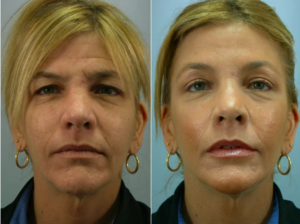Signs of aging are most visible in the face and neck. It’s not atypical for patients to notice a sagging brow and wrinkled forehead and wish to reverse the signs of aging.
Wrinkles and sagging on the face and neck can make you look tired, sad, and older than you are. As collagen and elastin break down, patients want to rejuvenate their skin for a younger look.
Many turn to either a brow lift or Botox to achieve the results they want. A brow lift is a more invasive, surgical procedure, but will yield longer-term results. Botox is less invasive and still very effective. Which procedure is right for you depends on a variety of factors, including desired results, age, recovery, and more.
We will break down the two procedures here.
In this article:
What is a Brow Lift?
A brow lift is a surgical procedure that can minimize the signs of aging in the forehead and restore a more youthful, refreshed appearance.
During a brow lift, the deep tissues over the forehead and brows are elevated and re-suspended by sutures. This reduces the appearance of forehead wrinkles and hooding over the eyes that make eyes look like they are drooping.

Browlift results
Good candidates for this procedure include physically healthy men and women who have realistic expectations and are interested in improving the appearance of the forehead area.
Though most patients are in their forties to their sixties, brow lifts may be performed at just about any age when the face and forehead area have begun to show the signs of aging. Many patients choose brow lift surgery because their results truly lift the upper face. The results are also longer-lasting than Botox.
Brow lift recovery
Recovery from a brow lift usually takes around a week. After a brow lift, some swelling, bruising, and numbness can occur. Patients may experience some discomfort or a headache that can be controlled with pain medication.
Head dressings will be removed within three days after surgery, and patients should keep the head elevated during the first couple of weeks. Staples will be removed in one week.
The swelling should fade within about a week or so, though the bruising can take seven to ten days to fully fade. Endoscope procedures typically involve less bruising and swelling and a reduced recovery period.
Patients are typically able to return to work in about seven to ten days. More strenuous activities will need to be postponed for several weeks and sun exposure should be limited for several months.
What is Botox?
Botulinum toxin type A, more commonly known as Botox®, is used to treat a wide range of medical conditions. Essentially, Botox prevents specific muscle contractions, which diminishes the visibility of the active lines and wrinkles on your face.
Botox injections on the forehead to reduce the visibility of lines and wrinkles is a very common usage of Botox. Botox is FDA-approved for use in treating forehead and frown lines, as well as crow’s feet.
Botox takes just a few minutes to inject and is much less expensive than surgery. But, its results are not as long-lasting as the results of a surgical brow lift. It’s not uncommon for people to get Botox first, and then consider brow lift surgery if they want more extensive results.
Botox recovery
Botox requires little to no recovery, and you won’t have any bruising or stitches. Possible side effects might include pain, swelling, or bruising at the injection site.
